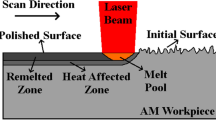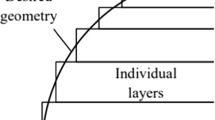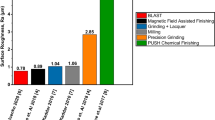Abstract
Additive manufacturing (AM) offers high design flexibilities and challenging approaches to produce highly complicated and intricate parts, which could not be possible to produce with traditional manufacturing methods. However, one of the significant drawbacks of AM processes is of course poor surface qualities, which are not acceptable for end products. Laser polishing (LP) offers an innovative surface-finishing technique that could be used to reduce the surface roughness by melting a thin layer of material on the rough part surfaces. This research work presents an extensive investigation of surface texture observed on laser polished surfaces of Ti-6Al-4V parts produced via electron-beam-melting process. A complete surface analysis of possible defects such as cracks, oxidation, and elevated edges and their causes are discussed in detail. It has been found that LP is capable of improving surface finish and the highest reduction in surface roughness can become from Sa = 44.14 μm to Sa = 3.69 μm. It is also shown that laser polishing might produce some surface defects and two detrimental surface cracks such as longitudinal and transverse might be evident depending upon the laser scan direction.























Similar content being viewed by others
Data availability
The authors confirm that the data supporting the findings of this study are available within the article [and/or] its supplementary materials.
Code availability
Not applicable.
References
Standard Terminology for Additive Manufacturing – General Principles –Terminology (ASTM International, 2015e). ISO/ASTM 52900. ASTM International, West Conshohocken, PA, USA
Allevi G, Cibeca M, Fioretti R, Marsili R, Montanini R, Rossi G (2018) Qualification of additively manufactured aerospace brackets: A comparison between thermoelastic stress analysis and theoretical results. Measurement 126:252–258. https://doi.org/10.1016/j.measurement.2018.05.068
Hunter LW, Brackett D, Brierley N, Yang J, Attallah MM (2020) Assessment of trapped powder removal and inspection strategies for powder bed fusion techniques. Int J Adv Manuf Technol 106(9-10):4521–4532. https://doi.org/10.1007/s00170-020-04930-w
Al-Tamimi AA, Hernandez MA, Omar A, Morales-Aldana DF, Peach C, Bartolo P (2020) Mechanical, biological and tribological behaviour of fixation plates 3D printed by electron beam and selective laser melting. Int J Adv Manuf Technol 109(3-4):673–688. https://doi.org/10.1007/s00170-020-05676-1
Liu SY, Shin YC (2019) Additive manufacturing of Ti6Al4V alloy: A review. Mater Design 164. doi:UNSP 107552. https://doi.org/10.1016/j.matdes.2018.107552
Huang RZ, Riddle M, Graziano D, Warren J, Das S, Nimbalkar S, Cresko J, Masanet E (2016) Energy and emissions saving potential of additive manufacturing: the case of lightweight aircraft components. J Clean Prod 135:1559–1570. https://doi.org/10.1016/j.jclepro.2015.04.109
Semnani D (2017) Geometrical characterization of electrospun nanofibers. Woodhead Publ Ser Te 186:151–180. https://doi.org/10.1016/B978-0-08-100907-9.00007-6
Gu B, Helvajian H, Piqué A, Witkin D, Helvajian H, Steffeney L, Hansen W (2016) Laser post-processing of Inconel 625 made by selective laser melting. Paper presented at the Laser 3D Manufacturing III,
Qian M, Xu W, Brandt M, Tang HP (2016) Additive manufacturing and postprocessing of Ti-6Al-4V for superior mechanical properties. MRS Bull 41(10):775–783. https://doi.org/10.1557/mrs.2016.215
Tian Y, Gora WS, Cabo AP, Parimi LL, Hand DP, Tammas-Williams S, Prangnell PB (2018) Material interactions in laser polishing powder bed additive manufactured Ti6Al4V components. Addit Manuf 20:11–22. https://doi.org/10.1016/j.addma.2017.12.010
Ma CP, Guan YC, Zhou W (2017) Laser polishing of additive manufactured Ti alloys. Opt Lasers Eng 93:171–177. https://doi.org/10.1016/j.optlaseng.2017.02.005
Rosa B, Mognol P, Hascoet JY (2015) Laser polishing of additive laser manufacturing surfaces. J Laser Appl 27. doi:Artn S29102, https://doi.org/10.2351/1.4906385
Lambarri J, Leunda J, Soriano C, Sanz C (2013) Laser surface smoothing of nickel-based superalloys. Lasers in Manufacturing (Lim 2013) 41:255–265. https://doi.org/10.1016/j.phpro.2013.03.077
Marimuthu S, Triantaphyllou A, Antar M, Wimpenny D, Morton H, Beard M (2015) Laser polishing of selective laser melted components. Int J Mach Tool Manu 95:97–104. https://doi.org/10.1016/j.ijmachtools.2015.05.002
Li YH, Wang B, Ma CP, Fang ZH, Chen LF, Guan YC, Yang SF (2019) Material Characterization, Thermal Analysis, and Mechanical Performance of a Laser-Polished Ti Alloy Prepared by Selective Laser Melting. Metals-Basel 9(2):112. https://doi.org/10.3390/met9020112
Yung KC, Zhang SS, Duan L, Choy HS, Cai ZX (2019) Laser polishing of additive manufactured tool steel components using pulsed or continuous-wave lasers. Int J Adv Manuf Technol 105(1-4):425–440. https://doi.org/10.1007/s00170-019-04205-z
Pong-Ryol Jang T-SJ, Ji K-H, Kim N-C (2016) A method of laser micro-polishing for metallic surface using UV nano-second pulse and CW lasers. Int J Adv Manuf Technol 85:2367–2375. https://doi.org/10.1007/s00170-015-7992-3
Genna S, Rubino G (2020) Laser Finishing of Ti6Al4V Additive Manufactured Parts by Electron Beam Melting. Appl Sci-Basel 10 (1). doi:ARTN 183, https://doi.org/10.3390/app10010183
Chai Y, Li RW, Perriman DM, Chen S, Qin QH, Smith PN (2018) Laser polishing of thermoplastics fabricated using fused deposition modelling. Int J Adv Manuf Technol 96(9-12):4295–4302. https://doi.org/10.1007/s00170-018-1901-5
Dewey MP, Ulutan D (2017) Development of Laser Polishing as an Auxiliary Post-Process to Improve Surface Quality in Fused Deposition Modeling Parts. Proceedings of the Asme 12th International Manufacturing Science and Engineering Conference - 2017, Vol 2
Guo W, Hua M, Tse PWT, Mok ACK (2012) Process parameters selection for laser polishing DF2 (AISI O1) by Nd:YAG pulsed laser using orthogonal design. Int J Adv Manuf Technol 59(9-12):1009–1023. https://doi.org/10.1007/s00170-011-3558-1
Hafiz AMK (2013) Applicability of a Picosecond Laser for Micro-Polishing of Metallic Surfaces. The University of Western Ontario, London, Dissertation
Xia MJ, Gu DD, Yu GQ, Dai DH, Chen HY, Shi QM (2016) Influence of hatch spacing on heat and mass transfer, thermodynamics and laser processability during additive manufacturing of Inconel 718 alloy. Int J Mach Tool Manu 109:147–157. https://doi.org/10.1016/j.ijmachtools.2016.07.010
Krishnan A, Fang F (2019) Review on mechanism and process of surface polishing using lasers. Front Mech Eng 14(3):299–319. https://doi.org/10.1007/s11465-019-0535-0
Cross CE (2005) On the origin of weld solidification cracking. Hot Cracking Phenomena in Welds:3-18. In: doi:Doi 10.1007/3-540-27460-X_1
Yusof F, Jamaluddin MF (2014) Welding Defects and Implications on Welded Assemblies. Comprehensive Materials Processing, In, pp 125–134. https://doi.org/10.1016/b978-0-08-096532-1.00605-1
Kadoi K, Fujinaga A, Yamamoto M, Shinozaki K (2013) The effect of welding conditions on solidification cracking susceptibility of type 310S stainless steel during laser welding using an in-situ observation technique. Weld World 57(3):383–390. https://doi.org/10.1007/s40194-013-0023-9
Dupont JLJ, Kiser S (2009) Welding metallurgy and weldability of nickel-base alloys. John Wiley & Sons, Inc., Hoboken, New Jersey
Ardakani HA, Naffakh-Moosavy H (2019) The effect of pulsed Nd:YAG laser welding parameters on defects of Kovar to AISI 304L dissimilar joint. Opt Laser Technol 118:62–68. https://doi.org/10.1016/j.optlastec.2019.05.003
Peters M, Kumpfert J, Ward CH, Leyens C (2003) Titanium alloys for aerospace applications. Adv Eng Mater 5(6):419–427. https://doi.org/10.1002/adem.200310095
Dong E, Yu W, Cai Q, Cheng L, Shi J (2017) High-Temperature Oxidation Kinetics and Behavior of Ti–6Al–4V Alloy. Oxid Met 88(5-6):719–732. https://doi.org/10.1007/s11085-017-9770-0
Mills KC (2002) Recommended values of thermophysical properties for selected commercial alloys. Woodhead, Cambridge
Acknowledgements
The authors would like to acknowledge ASELSAN A.S. for supplying the EBM specimens, IPG Photonics Eurasia for conducting laser polishing experiments, Metal Forming Centre of Excellence of ATILIM University for the surface roughness measurements, and of course Incekaralar A.S. for the surface inspections.
Author information
Authors and Affiliations
Contributions
All authors contributed to the study conception and design. Material preparation, data collection, and analysis were performed by [Safak NESLI] and [Oguzhan YILMAZ]. The first draft of the manuscript was written by [Safak NESLI] and all authors commented on previous versions of the manuscript. All authors read and approved the final manuscript.
Corresponding author
Ethics declarations
Ethics approval
Not applicable.
Consent to participate
Not applicable.
Consent for publication
Not applicable.
Conflict of interest
The authors declare that they have no conflict of interest.
Additional information
Publisher’s note
Springer Nature remains neutral with regard to jurisdictional claims in published maps and institutional affiliations.
Rights and permissions
About this article
Cite this article
Nesli, S., Yilmaz, O. Surface characteristics of laser polished Ti-6Al-4V parts produced by electron beam melting additive manufacturing process. Int J Adv Manuf Technol 114, 271–289 (2021). https://doi.org/10.1007/s00170-021-06861-6
Received:
Accepted:
Published:
Issue Date:
DOI: https://doi.org/10.1007/s00170-021-06861-6




